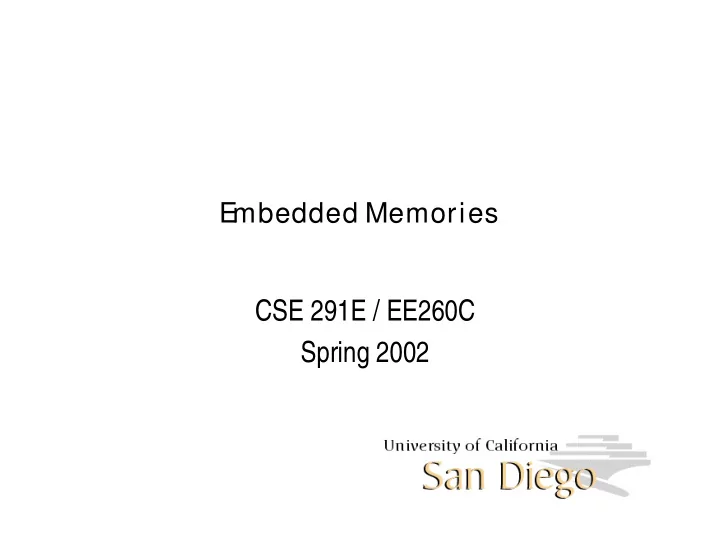

E mbedded Memories CSE 291E / EE260C Spring 2002
Outline • Embedded Memories – How memory fits into the roadmap • Memory Technology – SRAM, DRAM, ROM, Flash • DRAM Memory Architectures – Page Mode, SDRAM, Rambus Tim Sherwood 2
Introduction • Every embedded system needs memory – Buffering, Work Space, Instruction and Data Store • Fast growing, increasingly integrated • What are the needs of system? – High Bandwidth – Low Latency – Low Area/Cost – Non-volatility (in some cases) – Writable (in most cases) Tim Sherwood 3
E mbedded Memory Importance Tim Sherwood 4
Memory Tim Sherwood 5
Memory with col Tim Sherwood 6
Memory with Col and Bank Tim Sherwood 7
Options • SRAM Pros: Fast, available Cons: Volatile, Large Area • ROM Pros: Fast, Non-volatile, Extremely dense Cons: Can’t write, Requires data at fabrication • DRAM Pros: Very Dense, Writable Cons: Slow, Volatile, Requires refresh, Special process • Flash Pros: Dense, Writable and Non-Volatile Cons: Special Process, Slow Tim Sherwood 8
SRAM Cell • Basic 6-T SRAM cell • Stores the value in a pair of inverters • Both the value and it’s complement are read out • Gates connected to the word line control access Tim Sherwood 9
SRAM: How it works • Two modes of operation that share lines – Read and Write • Read Mode: – Both bit-lines must start out high, one of the two lines gets but pulled low (the pull-down is stronger than the bit-line) and this is how the result is read. • Write Mode – In order to perform a read, one bit line is set high and the other is set low. The pull down overpowers the value stored in the cell and you data is now stored in the cell Tim Sherwood 10
SRAM Cell Tim Sherwood 11
SRAM 2-Port Tim Sherwood 12
ROM • SRAM is big, 6-T for a single cell • If we know at fabrication time what the contents will be, and we don’t need to write them what can we do better? – Hard wire the values into the memory • Very dense layout • Very fast operation • Two types of ROM – Mask programmable – Diffusion programmable Tim Sherwood 13
Transistor at a zero NOR ROM Tim Sherwood 14
NOR ROM Layout Tim Sherwood 15
All WL high except selected row NAND ROM Tim Sherwood 16
NAND ROM Layout Tim Sherwood 17
Memory Comparison • All available today 1-Port SRAM 4k bit 8k bit 16k bit 32k bit 64k bit 0.44 0.7 1.24 2.18 3.93 Area (mm2) Delay (ns) 2.83 2.96 3.05 3.86 4.68 Power (mA/MHz) 0.15 0.175 0.18 0.226 0.285 2-Port SRAM 4k bit 8k bit 16k bit 32k bit 64k bit Area 170% 180% 180% 173% 182% Delay 118% 116% 116% 114% 100% 159% 146% 155% 160% 141% Power Diffused ROM 4k bit 8k bit 16k bit 32k bit 64k bit Area 27% 23% 18% 15% 13% 101% 106% 107% 95% 81% Delay 59% 69% 77% 76% 100% Power 0.35um CMOS (austria microsystems) Tim Sherwood 18
Memory Technology: DRAM • All we need to do is store a bit – then read it out right • Instead of storing the bit in a transistor – Use a capacitor • DRAMs use a transistor to guard a capacitor – Put data in, and disconnect it – Reconnect and read it out Tim Sherwood 19
DRAM Cell Tim Sherwood 20
DRAM Details • Pros Tiny design: 1 Transistor + 1 capacitor • One one word line and one bit line • In reality these to are even built on top of one another • Cons – Capacitor Design: Very small, high cap, 3D structures – Sense Amp Design: Small voltage (~100e) – Destructive Read: Spill the entire contents onto bit-line – Refresh: Puts the Dynamic in Dynamic RAM – Speed: Slower (tiny voltages, built for density) Tim Sherwood 21
DRAM structures Tim Sherwood 22
Flash Tim Sherwood 23
Flash Details • Pros: – High density – Writable and Readable – Store multiple bits per cell (multi-valued) – Non-volatile – Increasingly available for SOC • Cons: – Slow (90ns) – Field erase • Have to erase a whole section of the chip • Erase sets the bits to ‘1’, writing to them can turn them to ‘0’ Tim Sherwood 24
DRAM Memory Architectures • Even if the memory arrays are the same – The interface and interconnect can be different • Discuss 4 types of DRAM architectures – FPM, EDO, SDRAM, Rambus • All are built on the same basic memory tile – Difference lies in how data is accessed – And how the bus is designed • All need to send a row address and a collumn address Tim Sherwood 25
FPM Tim Sherwood 26
FPM Timing Tim Sherwood 27
E DO Tim Sherwood 28
E DO Timing Tim Sherwood 29
SDRAM Timing Tim Sherwood 30
Rambus Tim Sherwood 31
SDRAM • Large bus (64 bits) • 4 Banks per device, 4 banks total – Banks are across the devices … Addr Data 64b 8b Tim Sherwood 32
Rambus • Address and Data are uniformly loaded • 4 banks per device, 32 banks total (additive) • Reduces bank conflict probability Addr Data Tim Sherwood 33
Summary • Now you should know (at least at a high level) – How a SRAM works – How a ROM works – How a DRAM works – How Flash memory works – How to pick between them for your designs – What the differences are between • FPM, EDO, SDRAM, and Rambus Tim Sherwood 34
Recommend
More recommend